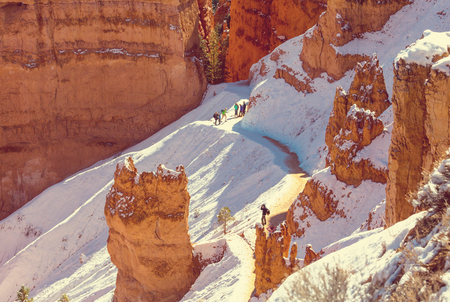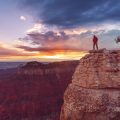Introduction to Bryce Canyon and Its Hoodoos
Nestled in southern Utah, Bryce Canyon National Park is a treasure trove for outdoor enthusiasts and nature lovers alike. Known for its jaw-dropping vistas and vibrant red-orange cliffs, this park stands out thanks to its iconic hoodoos—tall, thin spires of rock that rise dramatically from the canyon floor. These unique geological formations have been sculpted over millions of years by frost, water, and wind, creating a landscape that’s unlike anything else in the United States.
Bryce Canyon is not actually a true canyon but rather a series of natural amphitheaters carved into the edge of a high plateau. The parks elevation ranges from about 8,000 to 9,000 feet above sea level, providing cooler temperatures and panoramic views that stretch for miles. Visitors flock here year-round to experience its otherworldly scenery and vibrant colors that change with the light throughout the day.
What Makes Hoodoos Special?
The hoodoos are the stars of Bryce Canyon’s show. These irregular columns come in all shapes and sizes, often forming whimsical silhouettes that spark the imagination. The Paiute Native Americans believed the hoodoos were ancient people turned to stone as punishment—a testament to their mystical appearance.
| Hoodoo Feature | Description |
|---|---|
| Height | Up to 150 feet tall |
| Color | Vivid reds, oranges, whites, and pinks |
| Formation Process | Erosion from freeze-thaw cycles and rainwater |
| Main Viewing Areas | Queen’s Garden, Peekaboo Loop, Navajo Loop |
Bryce Canyon: More Than Just a Viewpoint
While many travelers enjoy Bryce Canyon’s overlooks from the rim, some of the most memorable experiences await those who venture down into the amphitheater. Trails like Queen’s Garden and Peekaboo Loop let you wander right among the hoodoos, immersing you in their surreal beauty and offering photo opportunities at every turn.
Why Explore Queen’s Garden and Peekaboo Loop?
The Queen’s Garden Trail is often considered one of the easiest ways to descend into the world of hoodoos. It connects with the more challenging Peekaboo Loop Trail, making it possible for adventurous hikers to witness some of the most stunning rock formations up close. Whether you’re new to hiking or an experienced trailblazer, these trails showcase why Bryce Canyon remains a must-see destination on any American Southwest road trip.
2. Trailhead Tips: Getting Ready for the Adventure
If you’re planning to hike the Queen’s Garden and Peekaboo Loop in Bryce Canyon National Park, getting prepared is key to having an amazing experience. Here’s what you need to know before you hit the trail.
What to Bring on Your Hike
| Item | Why You Need It |
|---|---|
| Sturdy Hiking Shoes | The trails can be rocky and uneven—protect your feet! |
| Plenty of Water | Bryces dry climate can sneak up on you. Carry at least 2 liters per person. |
| Snacks/Energy Bars | You’ll burn calories with all those elevation changes. |
| Sunscreen & Hat | The sun at high elevation is intense, even on cooler days. |
| Layered Clothing | Mornings can be chilly, but it warms up fast by noon. |
| Camera or Smartphone | You’ll want photos of those jaw-dropping hoodoos! |
| Map or Trail App | Cell service is spotty—download maps before you go. |
Trailhead Info: Where to Start Your Journey
The Queen’s Garden Trailhead is located near Sunrise Point, one of the most popular overlooks in Bryce Canyon. There’s a large parking lot, but it fills up quickly—especially during summer and holiday weekends. If you’re combining with the Peekaboo Loop, most hikers start at Sunrise Point, descend through Queen’s Garden, connect to Peekaboo Loop, and return via the Navajo Loop or backtrack up Queen’s Garden.
Getting There:
- By Car: Follow signs from the Bryce Canyon Visitor Center to Sunrise Point Parking Lot.
- By Shuttle (Seasonal): The park’s free shuttle stops at Sunrise Point—highly recommended during busy months!
Restrooms & Facilities:
- Restrooms are available at the trailhead year-round.
- No water refill stations on the trail—fill up before you start hiking.
Seasonal Tips for a Smooth Hike
| Season | Tips & Recommendations |
|---|---|
| Spring (March-May) | Trails may be muddy or icy in spots. Mornings are cold; dress in layers. Wildflowers begin blooming late spring. |
| Summer (June-August) | Start early to beat both crowds and heat. Afternoon thunderstorms are common—check weather updates! |
| Fall (September-November) | Crisp air and fewer crowds make this a favorite time for locals. Watch for early snow in late fall. |
| Winter (December-February) | The hoodoos look magical dusted with snow! Trails may be slippery; microspikes or traction devices are helpful. Dress warmly and check if trails are open. |
Pro Tip:
Bryce Canyon sits over 8,000 feet above sea level, so take it slow if you’re not used to high elevations. Hydrate often and rest when needed—you’ll enjoy those incredible views even more!

3. Queen’s Garden Trail: Awe-Inspiring Views and Local Lore
Discovering the Queen’s Garden Trail
The Queen’s Garden Trail is a must-see hike in Bryce Canyon National Park, drawing visitors from all over the United States and beyond. Famous for its easy access and jaw-dropping scenery, this trail is often recommended as the perfect introduction to Bryce Canyon’s otherworldly hoodoos. Starting from Sunrise Point, hikers descend into a fairy-tale landscape of orange spires, natural arches, and sweeping vistas that seem straight out of a western movie.
Breathtaking Viewpoints Along the Way
One reason locals and travelers alike love the Queen’s Garden Trail is its collection of stunning viewpoints. Here’s a quick guide to some highlights you won’t want to miss:
| Viewpoint Name | Mile Marker | What Makes It Special? |
|---|---|---|
| Sunrise Point | 0 miles (Trailhead) | Panoramic views of hoodoos glowing at sunrise; easy access from parking lot |
| Queen Victoria Hoodoo | ~0.8 miles | A unique rock formation resembling Queen Victoria herself—great photo spot! |
| Garden Alcoves | 1.0-1.5 miles | Shaded pockets with wildflowers in spring and summer; peaceful rest area |
The Legend Behind the Name: Local Lore
The Queen’s Garden gets its name from a hoodoo that many say looks just like Queen Victoria sitting on her throne. Early park rangers and local guides started pointing out this regal formation to visitors, and the name stuck. Today, spotting “the Queen” is a highlight for many hikers—so keep your eyes peeled as you explore! Stories about the hoodoos often reflect the playful imagination of both Native American Paiute traditions and early Western settlers, who saw faces, animals, and even royalty in these natural sculptures.
Why Hikers Love This Trail
- User-Friendly: The gentle descent makes it accessible for families and first-time canyon hikers.
- Photo Opportunities: Every turn offers another Instagram-worthy backdrop.
- Connects Easily: The trail links up with the Navajo Loop and Peekaboo Loop for longer adventures.
- Cultural Experience: Learn about local legends while enjoying one of America’s most unique landscapes.
Quick Tips for Your Hike
- Bring plenty of water—Bryce Canyon’s high elevation can be surprisingly dry.
- Wear sturdy shoes; though well-maintained, parts of the trail can be dusty or slippery.
- If you’re visiting in winter, check trail conditions with park rangers due to snow or ice.
This section of Bryce Canyon truly brings together natural beauty and local storytelling, making it a favorite for both seasoned hikers and those new to exploring America’s national parks.
4. Peekaboo Loop: Up-Close with the Hoodoos
If you’re ready for a real adventure in Bryce Canyon, the Peekaboo Loop Trail is where you’ll find it. This trail puts you right in the heart of the hoodoos, those towering spires that make Bryce so unique. Unlike some of the easier trails, Peekaboo Loop is a bit more challenging, but that’s part of what makes it so rewarding.
Trail Highlights
| Feature | Description |
|---|---|
| Distance | 5.5 miles (8.8 km) loop |
| Elevation Gain | About 1,500 feet (457 meters) |
| Difficulty | Moderate to strenuous—expect steep climbs and descents |
| Access Points | Start at Bryce Point or connect from Queen’s Garden/Navajo Loop |
| Best For | Experienced hikers seeking up-close views and fewer crowds |
Packed with Excitement: What to Expect on the Trail
The Peekaboo Loop winds through stunning amphitheaters filled with hoodoos, arches, and vibrant rock colors that shift as the sun moves across the sky. The trail features several steep switchbacks and narrow sections, so be sure to watch your footing—especially after rain or snow.
Panoramic Vistas Around Every Corner
This loop is famous for its sweeping views of Bryce Canyon’s wild landscape. From certain points, you can see all the way across the Bryce Amphitheater and out toward distant plateaus. Bring your camera—these are some of the best photo ops in the park.
Iconic Formations You’ll Encounter
- The Cathedral: A massive cluster of hoodoos that looks just like a natural church sanctuary.
- The Wall of Windows: Rock formations with large holes eroded through them—like nature’s own stained glass.
- Fairy Castle: A whimsical tower formation that sparks the imagination.
Tips for Hiking Peekaboo Loop
- Bring plenty of water: There’s little shade and it gets hot in summer.
- Pace yourself: The elevation and steep climbs can be tough if you’re not used to hiking in high country.
- Watch for horses: Peekaboo is shared with horseback riders—step aside and let them pass safely.
- Start early: You’ll beat the heat and enjoy more solitude on this less-traveled trail.
5. Essential Tips and Responsible Hiking in Bryce Canyon
Safety First: Key Advice for Hikers
Bryce Canyon’s Queen’s Garden and Peekaboo Loop trails offer stunning scenery, but it’s important to stay safe while exploring. The weather can change quickly, and elevation can surprise even experienced hikers. Here are some essential safety tips:
| Tip | Why It Matters |
|---|---|
| Check the Weather | Sudden storms or snow can make trails slippery and dangerous. |
| Stay on Marked Trails | Protects fragile soil and keeps you from getting lost. |
| Bring Plenty of Water | The high desert air is dry, and dehydration happens fast. |
| Wear Sturdy Footwear | Uneven terrain means good traction is a must. |
| Pace Yourself | The elevation (over 8,000 feet) can make hikes more strenuous than they appear. |
Leave No Trace: Protecting Bryce Canyon’s Beauty
Bryce Canyon’s hoodoos and unique landscapes are delicate. Help preserve them by following Leave No Trace principles:
- Pack it in, pack it out: Carry all your trash—including food scraps—back with you.
- Stay on established trails: Shortcuts damage fragile plants and soil structures.
- Avoid disturbing wildlife: Observe animals from a distance and never feed them.
- Take only pictures, leave only footprints: Don’t take rocks or plants as souvenirs.
- Respect quiet hours: Keep noise down to enjoy nature and respect other visitors.
Making the Most of Your Visit
Bryce Canyon is breathtaking year-round. To get the best experience:
- Start early or visit late: Sunrise and sunset light up the hoodoos with amazing colors, and crowds are smaller.
- Dress in layers: Temperatures can swing from chilly mornings to warm afternoons—even in summer.
- Download maps ahead of time: Cell service is spotty in the park; offline maps keep you on track.
- Stop at viewpoints: Pause at spots like Sunrise Point or Inspiration Point for panoramic views before or after your hike.
- Treat the landscape with care: Every step matters when hiking among Bryce’s one-of-a-kind formations.
Your Role as a Steward of Bryce Canyon
No matter how many times you visit, remember that Bryce Canyon’s magic depends on each visitor doing their part to protect it. By hiking responsibly, following park guidelines, and respecting nature, you help keep these incredible hoodoos standing tall for future generations to enjoy.


